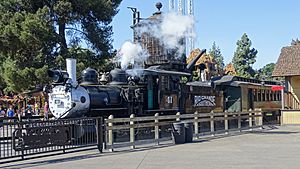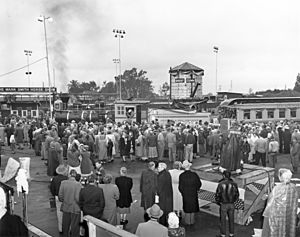- This page was last modified on 17 October 2025, at 10:18. Suggest an edit.
Ghost Town & Calico Railroad facts for kids
| Ghost Town & Calico Railroad | |
|---|---|

Ghost Town & Calico Railroad RGS 2-8-0 No. 41
|
|
| Preserved operations | |
| Owned by | Walter Knott |
| Commercial history | |
| Opened | January 12, 1952 |
The Ghost Town & Calico Railroad is a cool narrow-gauge heritage railroad. It's located inside Knott's Berry Farm, a fun amusement park in Buena Park, California. A narrow-gauge railway means its tracks are closer together than standard tracks. This railroad lets visitors experience what train travel was like in the old West!
Contents
How the Railroad Started
Walter Knott, the founder of Knott's Berry Farm, began building this railroad in 1951. He loved old trains and had collected many vintage train cars and equipment. He wanted to create a special train ride for his park visitors.
The first train rides started in November 1951. The railroad officially opened on January 12, 1952. It quickly became a popular attraction at the park.
Many of the Ghost Town & Calico Railroad's locomotives and cars have been restored. They now look like the trains from the old Rio Grande Southern Railroad and Denver and Rio Grande Western Railroads in Colorado.
Amazing Locomotives
The Ghost Town & Calico Railroad has some awesome steam locomotives. These are trains powered by steam, just like in the old days!
Steam Engines on the Tracks
The railroad has two special steam locomotives. They are called "Consolidation" type engines, built in 1881. They were originally used by the Denver & Rio Grande railroad.
- One is D&RGW No. 340, also known as Green River. For many years, it was called Gold Nugget No. 40 at the park. It was rebuilt in 2016 and is still running.
- The other is RGS No. 41, named Red Cliff. On January 12, 2012, it was renamed Walter K to honor Walter Knott. Both engines take turns pulling the trains.
The Unique Galloping Goose
The railroad also has a very unique vehicle called the "Galloping Goose" motor rail bus. These vehicles helped the Rio Grande Southern railroad stay in business in the 1930s. They were used to carry mail and sometimes a few passengers.
Knott's Berry Farm bought RGS Motor #3. It runs on the Ghost Town & Calico Railroad during quieter times. This is when there aren't enough passengers to need a big steam locomotive.
How the Galloping Goose Was Built
The Galloping Goose was first made from a Pierce-Arrow limousine. Imagine a fancy car turned into a train! It had a car frame, engine, and body. Train wheels were added to the back axle. Later, a special train truck (bogie) replaced the rear axle.
The original wooden car body was replaced after World War II with a bus body. The engine has also been changed a few times over the years. In 1997, it got a new Cummins Diesel engine. This engine was supported by a strong metal frame from an old roller coaster!
Other Engines at the Park
In 1973, the park received another steam locomotive, ex-D&RGW K-27 #464. This was a "Mikado" type engine. However, it was too big for the tracks and tunnels at Knott's Berry Farm. So, the park later gave it to the Huckleberry Railroad in Flint, Michigan.
Around 2010, an H.K. Porter "tank locomotive" named "Jennie K." came to Knott's. There were plans to fix it up, but it didn't happen. In 2017, it was sold to Garner Holt, who plans to restore it.
Train Cars and Coaches
The Ghost Town & Calico Railroad has different types of cars for passengers and display.
Cars for Passengers
When the railroad first opened in 1952, the steam engines pulled several yellow wooden passenger coaches. One special car was the No. 103 parlor car Chama. In 1954, it was changed into a "combination baggage/coach" car called Calico. It even had fake arrows stuck in it to look like an "Indian attack"! Those arrows have since been removed.
Today, the cars are painted a classic Pullman-green color. The train also includes:
- A gondola car, which was originally a flat car. It was changed to have open-air seating for passengers.
- A stock car, which was once a gondola. It now has benches and a wheelchair lift.
- Rio Grande Southern 0402, the only caboose on the railroad. It's still used today.
Cars on Display
Some special cars are kept on display or used for unique purposes:
- The parlor car Durango was restored in 2011.
- The Silverton observation sleeper car.
- The No. B-20 Edna business car.
- A short two-axle "bobber" caboose.
- A wooden box car D&RGW No. 3350.
The Silverton has now been changed to carry passengers. The caboose is used for "bandits" to jump on during the train ride show!
The Edna Business Car
The B-20 Edna business car was once called San Juan. It was built for Otto Mears, the president of the Rio Grande Southern Railroad. He used it as a portable office and temporary home. He would stay in it while checking the train tracks.
The Edna car had many features for its time:
- An outdoor pantry for food.
- A kitchen (galley) with a stove and oven.
- A sleeping area for the crew.
- A bathroom.
- A stateroom with a large bed and closet.
- A big open area that could be an office, sleeping space, or dining area.
It also had large windows and an open back platform. This made it easy to inspect the tracks and enjoy the view. While it was fancy for its time, it's much simpler than today's modern motor homes!
Images for kids
-
This photo of a Rio Grande Southern business-car train in the 1800s shows what the Ghost Town & Calico engines looked like in the 1800s (e.g., diamond stack, wooden pilot, and trim on the sand dome and steam dome). The business car next to the engine is the "Rico," which is now at the Colorado Railroad Museum. The other business car appears to be the "Edna," which is now at Knott's Berry Farm.
-
These cars on the Cumbres & Toltec Scenic Railroad are painted in the Passenger Car Red color that the GT&C cars had when they were originally built in the 1800s.
-
The GT&C business car Edna was originally the traveling office and living quarters of Otto Mears, the first president of the Rio Grande Southern Railroad, who named it the San Juan in 1890. However, three years later, the RGS went into receivership in the silver panic of 1893. Edward Turner Jeffery, the president of the Denver & Rio Grande Railroad (which held a large block of RGS bonds) became the receiver, and later president of the RGS. In 1899, the car was named for his daughter, Edna. Jeffery served as president of the D&RG, the RGS, and later, the Western Pacific Railroad concurrently. The Edna is one of only a small handful of narrow-gauge business cars in the United States still in existence.








